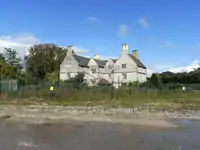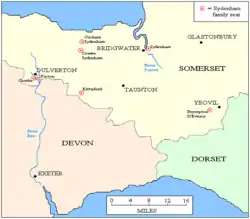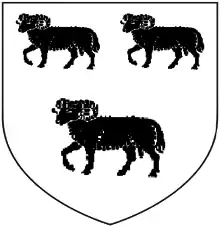Manor of Sydenham
The Manor of Sydenham was a historic manor in Somerset, England, about one mile (1.6 km) north-east of the centre of historic Bridgwater. Sydenham House, the manor house, a grade II listed[1] building situated in the parish of Wembdon,[2] was built in the early 16th century and refronted and rebuilt after 1613.[3] In 1937, British Cellophane Ltd set up production and built extensive factories on 59 acres (24 ha) of land ("Sydenham Manor Fields") adjacent to the manor house. Production ceased in 2005 and between 2010[4] and 2015 the industrial site was razed to the ground. In 2015 the razed site is owned by EDF Energy, which in 2012 purchased the manor house with the former factory site, intended for construction of temporary accommodation for 1,000 workers[5] on the proposed new Hinkley Point C nuclear power station[6] 12 miles (19 km) away. The Manor House is situated to the north side of the A39 Bath Road. Its owners were on the losing side in the Civil War and again in the Monmouth Rebellion.[7]




Descent

de Sydenham
It was the earliest known seat of the de Sydenham (later Sydenham) family,[8][9] which took its surname from the manor.
The family split into many prominent branches, the senior branch seated at Sydenham and Kittisford died out in the male line in the 15th century when Sydenham passed via the heiress to the Cave family, then to the Percival family, later Earl of Egmont. The next senior line was seated in the early 15th century at Combe Sydenham in Somerset, of which family was Simon Sydenham (died 1438), Bishop of Chichester, and later inherited the Somerset manors of Orchard Sydenham (later called Orchard Wyndham) and Brympton d'Evercy, which latter remained the seat of the Sydenham baronets, which title was created in 1641.[10] Another branch was seated at Combe, Dulverton and were lords of the manor of Dulverton.
Percival

Percival lords of the manor of Sydenham included:
- Richard Percivale (1550–1620) an administrator and politician, also known as a Hispanist and lexicographer. He wrote a Spanish grammar for English readers. He was the eldest son and heir of George Perceval (1561–1601) of Sydenham, by his wife Elizabeth Bampfylde, a daughter of Sir Edward Bampfylde (d.1528)[12] of Poltimore, Devon and Elizabeth Wadham, daughter of Sir Nicholas Wadham (died 1542) of Edge, Branscombe and Merryfield, Ilton. He was the ancestor of the Earls of Egmont.
British Cellophane Ltd
In 1935 British Cellophane Ltd. purchased the house and surrounding land from Philip Sturdy, who had acquired it in 1921 and had added additional land purchased in 1927. Sydenham House was restored in the 1960s and again in the 1980s, and in 1987 served as a conference and hospitality centre for British Cellophane Ltd.[13]
Historical events
In 1381 Sydenham House was sacked by Bridgwater's peasants under Nicholas Frampton during the Peasants' Revolt of 1381.[14] The local tax collectors were murdered and the town's records were destroyed.[15]
Further reading
- Ward-Jackson C.H., An Account of Sydenham Manor House and some of its former owners, 1986 (Author of: The Cellophane Story. Origins of a British Industrial Group, Bridgwater, William Blackwood & Sons Ltd., for British Cellophane Ltd., 1977)
- Sydenham, Dr George Francis, History of the Sydenham Family, Collected From Family Documents, Pedigrees, Deeds, and Copious Memoranda by the Late Dr. G. F. Sydenham, of Dulverton, Allan Thomas Cameron (ed.), privately printed by Dwelly, E., East Molesey, Surrey, 1928, in an edition of 300 copies.[16] The author was born at Combe, Dulverton.
- Anderson, James, A Genealogical History of the House of Yvery, in its Different Branches of Yvery, Luvel, Perceval and Gournay, Volume 1, London, 1742
- Baggs, A.P. & Siraut, M.C., 'Wembdon: Manors and Other Estates', in Victoria County History, Volume 6: Somerset: Andersfield, Cannington, and North Petherton Hundreds (Bridgwater and Neighbouring Parishes), ed. R W Dunning and C R Elrington, London, 1992, pp. 325–330
References
- Historic England. "Details from listed building database (1297180)". National Heritage List for England.
- A P Baggs and M C Siraut, 'Bridgwater: Economic history', in A History of the County of Somerset: Volume 6, andersfield, Cannington, and North Petherton Hundreds (Bridgwater and Neighbouring Parishes), ed. R W Dunning and C R Elrington (London, 1992), pp. 213-223
- Historic England. "Sydenham Manor House (1297180)". National Heritage List for England. Retrieved 13 October 2007.
- Guerrilla Explorer 2010 tour of derelict Cellophane factories on former "Sydenham Manor Fields"
- "Archived copy" (PDF). Archived from the original (PDF) on 2016-03-05. Retrieved 2015-09-01.CS1 maint: archived copy as title (link)
- See post to listed building text (comments) from Colin Buckley, 9 April 2015, presumably an agent acting for EDF:
- By way of explanation, EDF Energy acquired the land assets of the former Cellophane Factory to fulfil a part of the Hinkley Point C Development Consent Order to provide a construction worker accommodation campus in Bridgwater. Part of the purchased land, though not required for the accommodation campus, included Sydenham Manor House. The Cellophane Factory underwent demolition by its former owner and the land was remediated to parameters agreed by Sedgemoor District Council and The Environment Agency. The removal of the factory buildings and the remediation of the land involved the use of heavy plant and machinery which operated within close proximity to the manor house. This was the first reason for prohibiting both staff and visitors from entering the grounds. The manor house was surrounded by mature conifers which had previously been protected from prevailing winds by the bulk of the factory but suddenly became fully exposed. During the Winter gales of 2013 into 2014, a large proportion of the conifers to the West of the house were blown over causing serious damage to the perimeter fencing. The risk of further tree failures along with the hazard created by damaged wire fencing gave further reason for prohibiting visits. Finally a Section 106 agreement required the construction of two football pitches, one of which is adjacent to the house. Again the construction required use of heavy plant and machinery adjacent to the property with the only access route to the house travelling directly through the construction zone".
- "Roger Evans". Bridgwater Town Web. Archived from the original on 24 May 2011. Retrieved 14 March 2010.
- Collinson, 1791, Vol.3, p.86
- Collinson, Rev. John, History and Antiquities of the County of Somerset, Vol.3, Bath, 1791, p.547
- Burke, John & Burke, John Bernard, A Genealogical and Heraldic History of the Extinct and Dormant Baronetcies of England, Ireland and Scotland, 2nd edition, London, 1841, pp.514-5
- Debrett's Peerage, 1968, p.409, Earl of Egmont
- Vivian, Lt.Col. J.L., (Ed.) The Visitations of the County of Devon: Comprising the Heralds' Visitations of 1531, 1564 & 1620, Exeter, 1895, p.39, pedigree of Bampfield
- VCH, Baggs & Siraut
- "The Hospital of St John the Baptist Bridgwater". Friarn.co.uk. Archived from the original on 9 May 2008. Retrieved 18 August 2009.
- "Radical History". Bridgwater. Retrieved 20 January 2008.
- http://www.abebooks.com/History-Sydenham-Family-Collected-Documents-Pedigrees/12120185362/bd